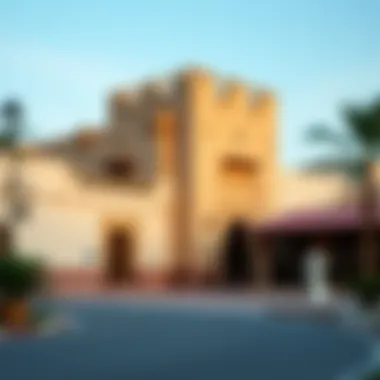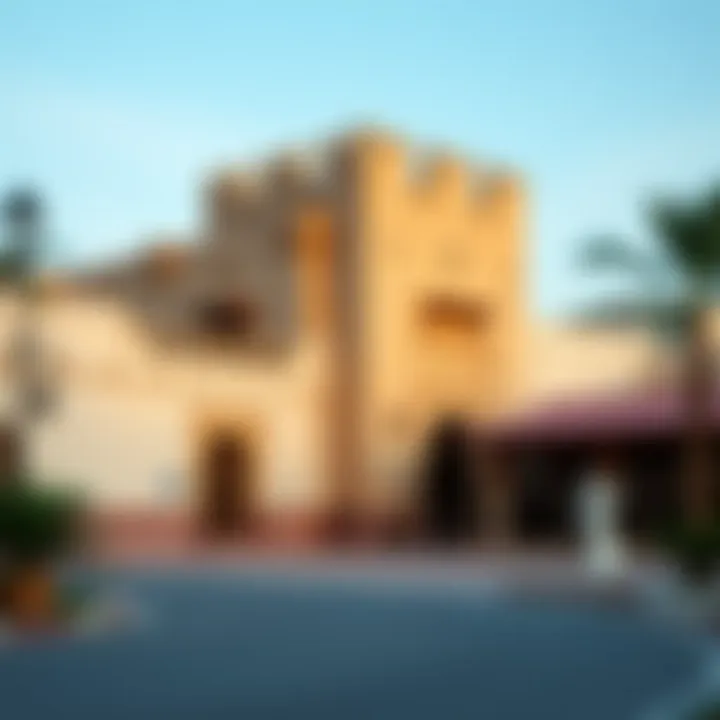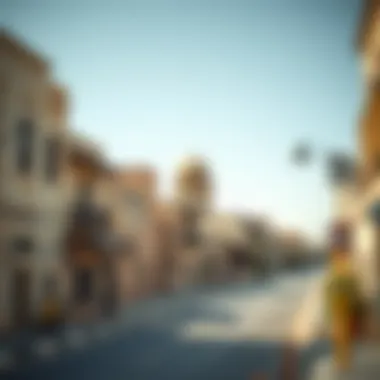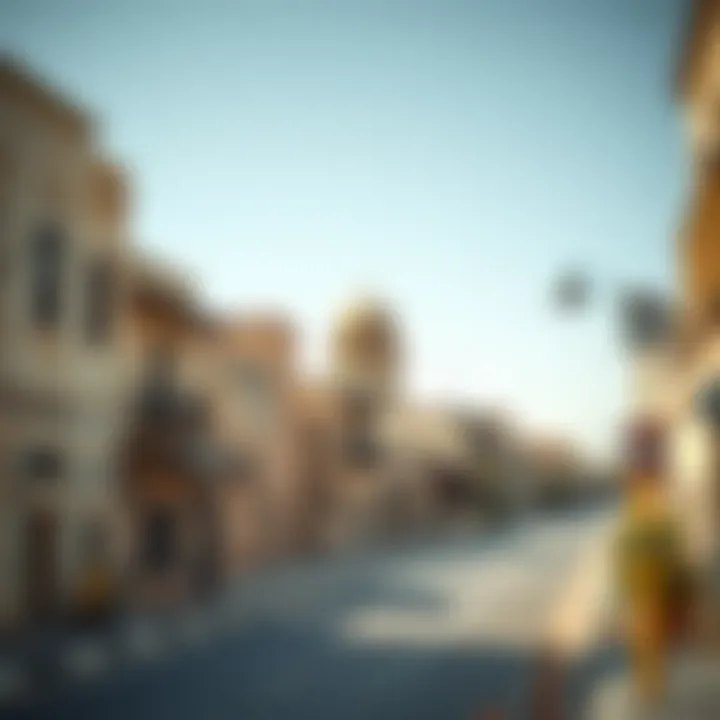Exploring Old Sarooj Al Ain: History and Heritage


Intro
Old Sarooj Al Ain stands as a testament to the rich heritage and cultural narratives woven throughout the history of Al Ain. Nestled within the emirate, this area offers a fascinating glimpse into the architectural splendor and communal life that flourished in the region. Taking a stroll through its streets is akin to stepping back in time, where the echoes of the past reverberate through the historic buildings and public spaces. Amid contemporary developments, Old Sarooj retains its unique charm, reflecting the identity of Al Ain—a city which balances the modern and the traditional.
The purpose of this article is to peel back the layers of Old Sarooj Al Ain, revealing its significance not only architecturally but also in terms of its socio-economic impact on the larger Al Ain urban fabric. We’ll explore the historical narratives that have shaped the area, as well as its relevance today, especially in terms of Dubai’s real estate landscape.
Understanding Old Sarooj is more than just appreciating old architecture; it encapsulates the ambitions and the struggles of the local populace, their relationship with their environment, and the socio-economic dynamics that have evolved over time.
Let us embark on this journey of exploration, examining the nuances of Old Sarooj Al Ain as we reveal its timeless allure and enduring significance in the ever-changing tapestry of urban life.
Historical Overview of Old Sarooj Al Ain
The Historical Overview of Old Sarooj Al Ain is a critical vein through which the heart of Al Ain's identity beats. It's not just about bricks and mortar; it's a reflection of a culture that has evolved through the sands of time. Understanding this history provides invaluable insight into the current socio-economic dynamics and cultural landscape of the region. This section aims to arm investors, developers, and cultural enthusiasts alike with a comprehensive understanding of the area's past, setting the stage for future developments and appreciation.
The Origins of Sarooj Al Ain
Diving into the origins of Sarooj Al Ain takes us back to a time when the landscape was significantly different. Archaeological evidence suggests habitation in this region circled back over a millennia, laying a strong foundation for what would eventually emerge as a vibrant community. The term ‘Sarooj’ itself is derived from the local reddish clay, employed by early inhabitants for construction. This natural resource not only shaped the physical space but also fortified community ties, as families often collaborated in construction efforts, using materials that were accessible and abundant.
When you walk through Old Sarooj Al Ain today, you might catch whispers of the past, stories of families that built their homes from this unique clay, creating living testimonies of resilience and community. Imagine the sights and sounds that would have accompanied the building of the first homes and the establishment of the first trade routes. Marking the origins turns the spotlight onto ancient industries, such as agriculture and trade with neighboring regions. Crops like date palms thrived, which in turn, supported livelihoods.
Significance in the Regional Context
As we shift our lens to the significance of Old Sarooj Al Ain within the broader regional context, we uncover a layer of interconnectivity that paints a bigger picture. Old Sarooj is often likened to a crossroads—not merely a geographic one, but a cultural and economic juncture. Historically, it has been a gathering point for traders, a hub where goods and ideas would flow freely, enhancing the socio-economic fabric of the region.
The cultural significance of Old Sarooj isn’t confined within its walls. Much like a well-rooted tree, its branches stretch across various aspects of life in Al Ain.
- Trade Routes: The strategic location of Sarooj made it an essential waypoint in ancient trade routes, ultimately influencing trade dynamics in the region.
- Cultural Exchange: With merchants and travelers coming through, the area became a melting pot of cultures, enriching the local customs, traditions, and dialects.
- Educational and Social Development: Throughout history, the area has served as a breeding ground for social cohesion and educational development.
"Old Sarooj Al Ain is not just a location; it represents a vibrant legacy, an amalgamation of histories that continue to resonate today.”
As we progress through this exploration of Old Sarooj Al Ain, it is important to recognize its unique role—not simply as a historical site, but as a pivotal contributor to the social and economic evolution of Al Ain. Viewing it through this lens provides not just an appreciation, but also a strategic advantage for those eyeing investment in this rich, multifaceted area.
Architectural Features
The architectural features of Old Sarooj Al Ain not only reflect a historical narrative but also encapsulate the identity of the community. These features provide insights into the building practices of the area, showcasing the harmony between functionality and aesthetic appeal. The significance of these attributes is multifaceted, playing a crucial role in attracting investors, developers, and buyers interested in historical preservation and urban development. Through an examination of materials, construction techniques, and preservation efforts, one gains a clearer understanding of Old Sarooj Al Ain's status within the broader urban landscape of Al Ain.
Materials and Construction Techniques
Old Sarooj Al Ain is a showcase of traditional building materials that were locally sourced. The main material used was mud brick, a timeless choice that provided insulation against the desert heat while being environmentally sustainable. These bricks were often mixed with palm fronds, which enhanced their structural integrity and durability.
The construction techniques utilized in the buildings reflect a profound understanding of the climatic conditions. For instance, the thick walls—often over a meter in depth—offer not just sturdiness but also significant cooling, keeping interiors comfortable during scorching summer days. Moreover, the elevated roofs and small windows were designed for ventilation, allowing hot air to rise while welcoming cooler breezes in.


"The use of natural materials creates a dialogue between the structure and the landscape, ensuring resilience and longevity over time."
Additionally, the craftsmanship seen in the arches and intricate door designs is a testament to the artisans' skill. Tools were simple, yet the precision and creativity employed are nothing short of remarkable. This blend of locally sourced materials and innovative techniques provides an important perspective on how historic communities adapted to and thrived in their environment.
Distinctive Architectural Styles
Distinctive architectural styles of Old Sarooj Al Ain reveal the cultural influences that have shaped the area over centuries. The interplay of Islamic architecture with local traditions creates a visually compelling narrative that draws the eye and sparks curiosity. Common elements include
- Courtyards: Central courtyards serve not only as communal spaces but also as a means to cool surrounding rooms.
- Mashrabiya: The intricate wooden latticework found in windows promotes privacy while allowing airflow and natural light.
- Domes and Arches: These structural features have both functional and aesthetic purposes, often adding grandeur to the otherwise austere desert landscape.
Particular buildings may exhibit Persian or Ottoman influences, showcasing how trade routes and cultural exchanges enriched the local architectural palette. Such a blend of influences underscores the importance of Old Sarooj Al Ain as a cultural melting pot. Developers and investors looking to preserve this heritage benefit from understanding these nuances, as it can influence the approaches they take in restoration and redevelopment.
Preservation Efforts
Recognizing the value of Old Sarooj Al Ain, various preservation efforts have been initiated in recent years. Local and national government bodies, along with community organizations, are working hand-in-hand to maintain and restore these architectural gems. One major initiative is the Al Ain Oasis Project, which aims to protect the historical landscape while promoting sustainable tourism.
Preservation strategies involve:
- Documentation: Keeping accurate records of structural conditions and historical significance.
- Renovation: Employing traditional techniques and materials during restoration to maintain authenticity.
- Public Awareness: Educational programs that inform the community about the cultural significance of preserving architectural heritage.
The delicate balance between modernization and conservation is paramount. Investors looking at opportunities within Old Sarooj Al Ain can find unique propositions in this endeavor: the chance to contribute to preservation while stimulating the local economy. As the area evolves, ongoing commitment to preservation will ensure that its splendor and historical importance endure for generations to come.
Cultural Significance
The cultural significance of Old Sarooj Al Ain cannot be understated. It serves as a living testament to the region's history, embodying the traditions and narratives that shaped the identity of its community. This area is not merely a physical space; it is a place where stories of resilience, adaptation, and unity unfold. The influence of cultural elements is deeply ingrained in the architectural landscape, local practices, and the very fabric of community life. In a world that's constantly in flux, Old Sarooj Al Ain stands as a beacon of heritage that promotes a sense of belonging among its residents.
Role in Community Identity
Old Sarooj Al Ain plays an integral role in defining the community's identity. Many locals derive a sense of pride from its rich past, where the old meets the new, blending various cultural influences. As families gather to reminisce about the stories passed down through the generations, the past becomes a part of their present. It's in the winding streets, bustling markets, and old buildings that they find echoes of their ancestors' lives.
- Cultural Heritage: This site encapsulates the ancestral wisdom and values that are crucial for maintaining the community's unique identity. It channels the spirit of the people, celebrating their way of life.
- Place of Gathering: Old Sarooj provides a central place for events, allowing residents to connect and strengthen ties. It is often where discussions about the future of the neighborhood take place while honoring its history.
This connection to place fosters not just pride but also a collective responsibility to preserve what makes them unique. The respect for heritage can easily be observed in the careful maintenance of historical structures.
Festivals and Cultural Events
Festivals and cultural events in Old Sarooj Al Ain further cement its significance to the community and enhance its vitality. These events are not only about entertainment; they are vibrant celebrations that reflect the traditions, beliefs, and diversity of the residents.
- Annual Heritage Festival: This festival is a prime example of how the community comes together. With performances, traditional crafts, and local cuisine on display, it attracts visitors far and wide.
- Seasonal Celebrations: Events tied to the agricultural calendar, such as harvest celebrations, allow for deep-rooted cultural practices to be evident. These gatherings often include folk music, dance, and storytelling, reinforcing shared traditions.
- Community Markets: Regular markets provide a hub for local artisans where they can showcase their crafts. This generates economic benefits while simultaneously preserving traditional skills and crafts.
"Old Sarooj Al Ain is not just a place you visit, it is a community rooted in history and alive through its culture."


Through such events, Old Sarooj Al Ain showcases its cultural richness, drawing in those wishing to explore or partake in its heritage. This not only benefits the local economy but reinforces the bonds among community members, making Old Sarooj a vital part of Al Ain’s ongoing narrative.
Impact on Local Economy
The economic landscape of Al Ain has been significantly shaped by Old Sarooj Al Ain, impacting both the local livelihoods and the broader regional economy. As this area attracts more visitors and investment, its economic contributions become increasingly undeniable. The juxtaposition of historical charm and modern development creates a unique environment that enhances both tourism and real estate, thereby generating a circular flow of benefits within the local economy.
Tourism and Its Economic Benefits
Tourism is often the bread and butter of many local economies, and in the case of Old Sarooj Al Ain, it is no different. The area draws both domestic and international tourists, eager to experience its rich heritage. This influx of visitors contributes to various sectors:
- Hospitality Sector: Hotels, guesthouses, and other accommodations benefit from the steady stream of tourists, driving their revenues up.
- Local Artisans: Tourists often favor handcrafted goods and traditional art, providing local craftsmen a platform to showcase their talent.
- Food and Beverage: Local restaurants and cafes thrive on visitors looking to enjoy regional cuisine, significantly boosting their sales.
- Cultural Experiences: Tourists frequently engage in guided tours and cultural workshops, creating jobs and fostering community involvement.
In quantifiable terms, areas rich in tourism like Sarooj Al Ain can witness revenue projections soaring by as much as 15-25% annually, creating a ripple effect in the economy.
"When history meets modernity, even small neighborhoods can become legends in their own right, impacting local economics significantly."
The essential aspect is that tourism doesn’t merely support businesses; it also heightens awareness around cultural preservation. As locals see value in their heritage through tourism, a greater emphasis is placed on conservation.
Real Estate Development Trends
As interest in Old Sarooj Al Ain continues to grow, the real estate landscape is undergoing notable transformations. Investors are not just looking for immediate profits; they recognize the potential for long-term gains in a historically rich area. The development trends reflect an increasing synergy between heritage and progress.
- Renovations and Restorations: Many older properties are being restored to their original glory. This not only retains the cultural authenticity but also increases property values.
- Modern Developments: Builders are keen to integrate modern amenities, which appeal to younger homeowners or investors. High-end apartments and mixed-use developments around Old Sarooj are rapidly becoming popular.
- Demand Outstripping Supply: As popularity soars, the demand for real estate opportunities in the area has led to shortages in available properties, driving prices higher.
- Community Constructs: More developers focus on creating community-oriented spaces that offer a blend of residential and commercial use.
In summary, the evolving dynamics around real estate here create a win-win situation where both investors and the community reap rewards. Enhanced property values translate into increased local spending, enriching the overall economic climate.
As Old Sarooj Al Ain continues to develop economically, it emphasizes the delicate balance between heritage conservation and modern development, thus setting a precedent for other regions eager to adopt this model.
Changes Over Time
The narrative of Old Sarooj Al Ain is not merely a path through dusty roads of history; it’s a vibrant tapestry rich with cultural threads that have been woven through the years. This particular topic of Changes Over Time is critical to our understanding of the place. It illustrates how the neighborhood has shifted with the winds of modernization, yet retained its soul. By examining both its historical evolution and modern transformations, we can grasp the delicate balance between preserving heritage and embracing progress.
Historical Evolution of the Neighborhood
Delving into Old Sarooj Al Ain's historical evolution uncovers layers that tell quite the story. Established not just as a residential area, it served as a hub for trade and social interaction. The paths carved out by traders and travelers from different parts of the region contributed to the rich cultural fabric, inviting a mix of customs and practices that still echo today.
As the emirate of Abu Dhabi began to take shape, Old Sarooj marked its significance as part of the burgeoning urban landscape. With each decade, the neighborhood saw architecture evolve, moving from simple mud-brick constructions to more elaborate designs incorporating materials like coral and stone. For example, the early homes, built to withstand the arid climate, were engineered using techniques passed down through generations. Small courtyards captured the breeze, offering a respite from the searing heat.
Additionally, governmental initiatives in the mid-20th century spearheaded various renovation projects aimed at redeveloping key areas within Old Sarooj. These efforts sought to preserve the essence of the neighborhood while ensuring it met new urban demands. This delicate tethering of past to present is a testament to its significance in sustaining local identity amid shifting societal values.
Modern Transformations


The modern transformation of Old Sarooj Al Ain has brought about both opportunities and challenges. The neighborhood has evolved into a dynamic enclave that attracts real estate investors, developers, and residents seeking a blend of historical charm and contemporary convenience. The introduction of amenities and facilities has expanded the appeal of the area, turning it into a nexus of activity and economic growth.
Developments such as new parks, shopping centers, and educational institutions have created a more urban feel, driving foot traffic and enhancing local commerce. Here’s a snapshot of some key modern changes:
- Infrastructure Improvements: Roads have been upgraded, fostering better connectivity to Al Ain's main thoroughfares.
- Cultural Centers: New establishments promote arts and heritage. These venues often celebrate traditional crafts, offering workshops that link the past to the future.
- Residential Developments: New housing options cater to modern living, yet designed to reflect traditional Emirati aesthetics. This blend respects the cultural narrative while providing necessary comfort and functionality for today's families.
However, these transformations are not without their complications. The influx of new establishments can sometimes overshadow the very cultural heritage that draws people to Old Sarooj in the first place. Striking a balance between development and preservation remains a critical issue for stakeholders involved. The future will likely see ongoing discussions regarding sustainability and cultural integrity, ensuring that Old Sarooj retains its unique identity even as it adapts to the modern world.
"Development is like a double-edged sword; it can either cut through to the heart of progress or sever the ties to our roots."
For readers particularly interested in the blend of heritage with the modern touch, understanding these ongoing changes is vital. In the end, the transformative narrative of Old Sarooj Al Ain does not imply an abandonment of its past but rather an evolving journey toward a vibrant future that honors its significant heritage.
Future Prospects
The future of Old Sarooj Al Ain holds both promise and challenges, making it a critical focus for stakeholders within the community and beyond. As the landscape of Al Ain continues to evolve, understanding the potential trajectories for Old Sarooj Al Ain can provide crucial insights for investors, developers, and residents alike. With its rich history and cultural significance, the area is poised to play a vital role in shaping the future identity of this region.
Vision for Al Ain
The vision for Al Ain encompasses a multifaceted approach to urban development that harmonizes historical integrity with modern needs. As authorities and urban planners look towards creating spaces that respect Al Ain's traditions, Old Sarooj can serve as a model. Here, the aim is not solely to preserve the past but to make it interact dynamically with the present and future.
Key elements of this vision include:
- Preservation of Heritage: Protecting Old Sarooj's architectural integrity is essential. By implementing policies that safeguard its distinct buildings and cultural heritage, the community can maintain its unique character.
- Sustainable Development Plans: Developing an environment that supports tourism while integrating local business needs is vital. Initiatives that foster community involvement and economic opportunities can elevate both local pride and economic benefits.
- Public Spaces: Creating accessible public spaces ensures that both residents and visitors can engage with the heritage of Old Sarooj. Parks, cultural plazas, and walkable areas will encourage social interaction and strengthen community ties.
With these components in mind, stakeholders can shape a vision that not only respects the past but also thrives in the future.
Sustainability Challenges
While the future seems bright, there are sustainability challenges that park this trajectory. As development continues, it’s crucial to balance economic growth with environmental stewardship. Key challenges include:
- Resource Management: Scarcity of water and other resources remains a pressing issue. Sustainable practices in water usage, like rainwater harvesting and energy-efficient construction, will be crucial.
- Managing Urbanization: Rapid urban growth can strain local infrastructure. Ensuring that growth is matched with the necessary public services will be essential to maintain quality of life.
- Community Engagement: Engaging local communities in the decision-making process is vital. Without their input and support, initiatives may lack the necessary local resonance and ultimately fall flat.
“Sustainability is not about being green; it’s about ensuring our future without compromising our heritage.”
In essence, the path forward for Old Sarooj Al Ain is laden with both opportunities and difficulties. Balancing the weight of history with the demands of modern life will require thoughtful engagement, innovative strategies, and a commitment to sustainability that respects the area’s rich heritage. With a clear vision and proactive measures, the potential for Old Sarooj Al Ain can be fully realized, ensuring it remains a cherished part of Al Ain's narrative.
Closure
The conclusion of our exploration into Old Sarooj Al Ain serves as a vital component that stitches together the diverse threads of history, architecture, and cultural significance presented throughout the article. It offers more than just a summary; it is a reflection on the enduring essence of this landmark, encapsulating its influence within the broader tapestry of Al Ain's urban narrative. Through this concluding section, readers are invited to appreciate the nuances of the site that go beyond mere bricks and mortar, delving into how Old Sarooj Al Ain continues to shape identities, foster community pride, and stimulate economic activity.
Summarizing Key Insights
In recapping the discussion, the core insights highlight the multifaceted role that Old Sarooj Al Ain plays in the region:
- Historical Foundation: The origins of Sarooj Al Ain lay the groundwork for understanding its significance as more than just an architectural piece.
- Architectural Distinction: Its unique styles and construction techniques reflect a blend of heritage and practicality, representing a proud history.
- Cultural Heartbeat: The community's connection to the landmark is palpable, showcasing how festivals and events breathe life into its historic walls.
- Economic Catalyst: The area’s ongoing transformation points to its potential in shaping tourism and real estate developments in Al Ain.
Final Thoughts on Old Sarooj Al Ain
Bringing these insights together underscores the importance of safeguarding Old Sarooj Al Ain for future generations. It is more than just a physical entity; it is a symbol of past resilience and future possibilities. As urban landscapes evolve, the challenge remains to balance growth with preservation. Stakeholders, including investors and developers, must navigate this landscape carefully, ensuring that the essence of Old Sarooj Al Ain is honored while embracing the necessary modern advancements. The future looks promising, provided that the lessons of the past continue to inform the development narrative moving forward. Readers are encouraged to engage actively with historical landmarks like Old Sarooj Al Ain, recognizing their role not just as relics of history, but as vibrant parts of a living community.







